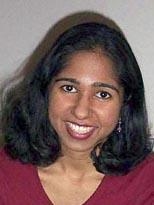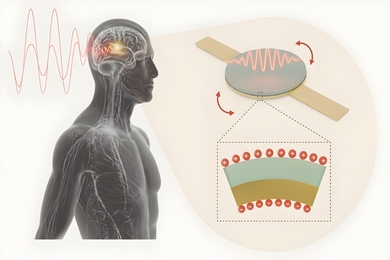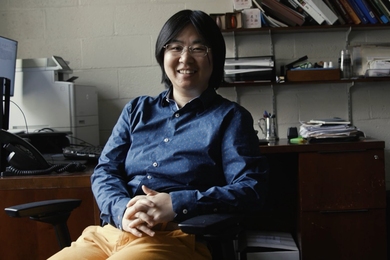Chemistry may be Mala Radhakrishnan's first love, but she more recently found another: writing poetry. A former high school chemistry teacher who used storytelling in her lessons, Radhakrishnan is currently pursuing her Ph.D. in physical chemistry at MIT. Radhakrishnan has compiled her earliest poems into a collection titled, "Chemistry for the Couch Potato" and is working on a larger book composed entirely of chemistry poetry. She says it's intended for students and teachers in high school and college chemistry classrooms as well as anyone who loves science.
Radhakrishnan will be one of a dozen area poets included in "Dr. Brown's Traveling Poetry Show," which will take place on Tuesdays at the Zeitgeist Gallery starting next week.
Lynn Heinemann of the Office of the Arts recently asked Radhakrishnan about her poetry.
Q. How did you start writing "chemistry poetry"?
A. I taught chemical concepts to my high schoolers by using stories and analogies that personified the atoms and molecules--that's how I think about chemistry, and they seemed to understand the material better. After I came to MIT, I started frequenting the Cantab Lounge on poetry night and was inspired to write poetry. An obvious thing for me to write about, since I like it so much, was chemistry. So I essentially began putting the stories I used into poetic form.
Q. Did your interest in words develop at the same time as that in science?
A. I never in a million years thought I'd be writing poetry and that people would actually want to listen to it. I've always liked science. Poetry is something I only recently got into. But now, I'm quite hooked!
Q. How does your work at MIT inspire your poetry?
A. It constantly gives me new ideas for poems. For example, if I am suddenly working on a project involving a specific chemical process that I think is neat, I'll write a poem about it.
Q. What prompted your career change from teaching?
A. I knew I wanted to go as far as I could in science, educationally. It was out of an old-fashioned love of science. So I figured I would return to get my Ph.D. sooner rather than later. But it was difficult to pull myself away from teaching through Teach for America--I loved it! I would like to have a career that ultimately combines teaching (especially high school level), creativity, working with people, and being able to somehow involve myself in cutting-edge research to some extent. I don't know if such a career exists now, but perhaps that's where the "creativity" part comes in.
"Dr. Brown's Traveling Poetry Show" opens Tuesday, April 5, at 7:30 p.m. at the Zeitgeist Gallery, 1353 Cambridge St., Cambridge.
The Radioactive Dating Game
By Mala L. Radhakrishnan
I used to sleep 'til my electrons would drool
At P-32 element-ary school.
The things we were taught were just totally boring.
A mole of us atoms would always be snoring.
But one thing I learned there I've kept to this day:
"Soon, my students you'll beta decay
To become more mature and to capture the label
Of "S-32", and then you'll be stable.
And when that time comes you will celebrate
'Cause you will be ready to graduate.
So look around now, and count every peer.
Today there's a mole, but you'll soon disappear."
So I watched as my friends around me decayed.
I felt left behind, slow and dismayed.
Abandoned by those who were thought to be deft.
In two weeks there was but half us of left.
Meanwhile I'd hoped to impress my young lass
But was now in the bottom half of the class.
I spent all my class time planning to court her,
But remained, two weeks more, in the leftover quarter.
By two weeks more yet, and I still hadn't parted.
Now six weeks had passed since this challenge first started.
What was my problem? I kept losing faith.
The fraction of atoms left was one-eighth.
Another two weeks and my hope for love waned.
One sixteenth of a mole of us atoms remained.
My lass had now probably found a new mate.
By the time I escaped here, it would be too late.
So I studied the past eight weeks with great courage.
And suddenly a pattern started to emerge.
I realized, from evidence existential
That the decay of the class size was exponential.
See, every time two weeks came and then went,
The class size went down by fifty percent.
'Twas one mole times e to the minus kt,
Where k was ln 2 over 2 weeks, you see.
And "t" was the time in units of weeks
Since the teacher that lesson one fine day did speak.
This equation did serve as a useful tool;
I could predict, at time t, the number in school.
But then it happened - I had my decay!
I was S-32, and I liked it that way.
Success carried with it the sweetest aroma,
My electrons excited as I got my diploma,
Which oddly contained a most curious addition.
It read: "You've earned honors and recognition
For insightfully doing the mental athletics
Of uncovering the inherent first-order kinetics."
When my love saw this honor she screamed out loud,
"Oh, my brilliant darling, of you I'm so proud!
Your wit has won over my heart in a snap.
Let's let our orbitals overlap!"
So the one thing I learned from that school, 'twas the worst,
Is 'tis not about who's quick or who finishes first.
Everyone matures at different rates.
(But those who know learn chemistry will always get dates!)
A version of this article appeared in MIT Tech Talk on March 30, 2005 (download PDF).






